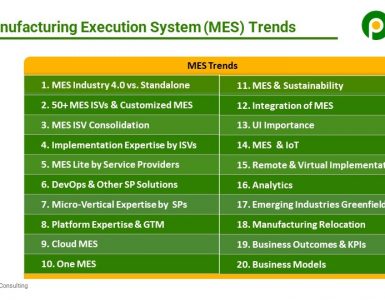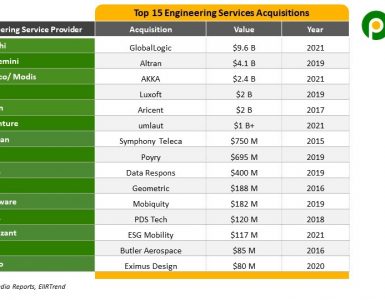In the most recent quarterly results for engineering services, an intriguing trend has emerged. Pureplay engineering service providers with higher revenue per employee experienced negative quarter-over-quarter (QoQ) growth, while those with lower revenue per employee saw positive QoQ growth. We delve into this trend in detail in our blog.

What accounts for the observed relationship between negative and positive QoQ growth rates and the revenue per employee among engineering service providers?
We examined the quarterly financial results of 14 leading pure-play engineering service providers. These providers span various engineering horizontals, including mechanical, embedded, software product engineering, and Industry 4.0, among others. They also cater to key engineering industry verticals such as automotive, aerospace, telecom, hi-tech, medical devices, and industrial equipment. Furthermore, these service providers have a global presence, with operations in Eastern and Western Europe, the US, Latin America, India, and other regions.
The quarter-over-quarter (QoQ) growth rates for these providers varied from -6% to 9%. While many showed negative QoQ growth, a few exhibited positive growth. What accounts for this variation in performance? There are certain headwinds, like software product engineering, which are facing challenges, and others, like automotive and aerospace, which are more like tailwinds and favorable for growth. However, these factors alone don't fully clarify the growth differences. For instance, while a majority of software product engineering firms experienced negative QoQ growth, some showed positive growth. Similarly, both negative and positive growth patterns are seen among automotive and aerospace-focused providers.
One factor accounting for this variation is the delivery regions, gauged using the metric "Revenue/Employee." There are three primary delivery regions, and service providers within each have distinct Revenue/Employee ranges:
- Onshore (US and Western Europe): Engineering service providers typically generate over $90K in Revenue/Employee.
- Nearshore (Eastern Europe and Latin America): The typical Revenue/Employee range for engineering service providers is between $70K and $90K.
- Offshore (India): Engineering service providers commonly yield less than $50K in Revenue/Employee
From the chart, it's evident that engineering service providers with higher Revenue/Employee are experiencing negative growth, while those with lower Revenue/Employee are seeing positive growth. This suggests that all onshore and nearshore-focused providers are facing negative quarter-over-quarter (QoQ) growth, with Globant being the only exception. Conversely, all offshore-focused providers are registering positive QoQ growth.
Why is this observation important?
This relation of Revenue/ Employee with growth rates is important for three reasons:
- More offshoring to India. If this trend continues, it suggests that enterprises are more inclined to offshore their engineering services to India over other locations. This shift is significant. Engineering is fundamental to enterprises, and a common belief is that it can't be easily outsourced, and even if it can, it's challenging to offshore on a large scale. This has historically given European service providers an edge due to their onshore presence. However, the pandemic has prompted enterprises to reevaluate these notions. As most work was done virtually, the importance of location has diminished. Consequently, enterprises are reconsidering their engineering operational models. India stands out in this respect, offering vast engineering talent at both scale and competitive price points.
- Inflection point of offshore engineering service offshoring. There's considerable debate about whether engineering services have hit a pivotal moment, and if the pandemic has fast-tracked the offshoring of these services, mirroring the boost in IT offshoring after the 2008 Global Financial Crisis. The recent performance of Indian engineering service providers, showing strong growth momentum even amid challenging macroeconomic conditions, is promising. If this trend persists, it could indicate that the tipping or inflection point for engineering offshoring has been reached.
- Indian footprints of onshore and nearshore-centric engineering service providers. Our industry checks indicate that onshore and nearshore engineering service providers are missing out on cost-saving contracts that are going to India-centric providers. In certain vendor consolidation initiatives, India-centric providers have assumed responsibilities previously held by onshore and nearshore providers. Global engineering service providers, which are localized in their delivery, are shifting to a more global model with a significant focus on deliveries from India. This mirrors developments in the IT services sector. Approximately 15 years ago, when offshoring reached its inflection point, the most successful global IT service providers were those who had invested in extensive delivery capabilities in India. A similar scenario seems poised to unfold in the engineering services sector this decade. Both onshore and nearshore providers have been expanding their presence in India, and this trend is likely to hasten their growth strategies in India, both organically and through acquisitions.
Bottomline: Is Offshoring the Future of Engineering Services?
When the broader economic climate improves, the current negative growth of onshore and nearshore service providers will likely rebound. At that juncture, it will be crucial to observe if a clear disparity persists in the growth rates between offshore-centric providers and their onshore and nearshore counterparts. If such a stark difference remains, we can confidently state that we've reached an inflection point where offshore engineering will outpace its onshore and nearshore equivalents in growth. Consequently, both Indian engineering and its service providers are positioned to grow significantly faster than the market. We can expect robust growth in the ensuing quarters and years. Onwards and Upwards!






 Pareekh Jain
Founder of Pareekh Consulting & EIIRTrends
Pareekh Jain
Founder of Pareekh Consulting & EIIRTrends
Add comment